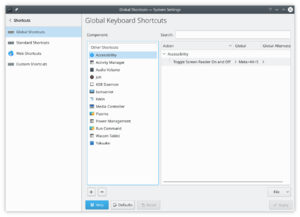System Settings/Shortcuts and Gestures/zh-cn: Difference between revisions
m Created page with "{{Note/zh-cn|1=这里的内容是写给 KDE 4.4 的,当然新版除了系统设置的布局有变动外,其他通用。}}" |
m Created page with "<menuchoice>系统设置 -> 输入动作</menuchoice> (KDE 4.5 后是 <menuchoice>系统设置 -> 快捷键和手势 -> 自定义快捷键</menuchoice>)" |
||
| Line 26: | Line 26: | ||
{{Note/zh-cn|1=这里的内容是写给 KDE 4.4 的,当然新版除了系统设置的布局有变动外,其他通用。}} | {{Note/zh-cn|1=这里的内容是写给 KDE 4.4 的,当然新版除了系统设置的布局有变动外,其他通用。}} | ||
<menuchoice>系统设置 -> 输入动作</menuchoice> (KDE 4.5 后是 <menuchoice>系统设置 -> 快捷键和手势 -> 自定义快捷键</menuchoice>) | |||
===Enabling mouse gestures=== | ===Enabling mouse gestures=== | ||
Revision as of 11:42, 8 April 2012
 |
编辑系统级键盘快捷键和鼠标手势 |

自定义快捷键
设置输入动作,包含鼠标手势。

标准键盘快捷键
在这里可以为许多应用程序配置公用快捷键。包括如“打开”,“保存”,“关闭”,“剪切”,“复制”,“粘贴”,“查找”及更多行动。

全局键盘快捷键
用来操作后台程序的全局快捷键
鼠标手势
(KDE 4.5 后是 )
Enabling mouse gestures
In the bottom left corner of the window there is a button. Make sure that the checkbox is checked. Set the timout as you see fit. The mouse button might be different for you, I chose 3 for using the right mouse button. If you want input actions to be enabled automatically, check the "Start the input Actions daemon on login" above.
Creating the Mouse gestures actions group
Right click on the left pane (in an empty area under the list of action groups) and choose , rename that group to "Mouse Gestures" and check the checkbox attached to its name.
Creating a new mouse gesture
From now on I will assume that the new group is called "Mouse Gestures". Right click on and choose (here there are three options but I didn't manage to work with "Send Keyboard Input") using "Command/URL" or "D-Bus Command" you will need to create a gesture and bind an action to it.
To create the gesture
Click on your and select the tab. in the bottom of the screen there is an button (click it). In the box that just opened draw your gesture using the left mouse button.
To bind an action
if you chose simply enter that command/url under the tab at the field.
Examples using Command/URL
Close window
This command will let you close the next window you mouse click on.
Command/URL: wmctrl -c :SELECT:
to close the active window
Command/URL: wmctrl -c :ACTIVE:
Translate clipboard content
This command will display a translation of the current clipboard content.
- Required for this are:
- xclip
- libtranslate
'"`UNIQ--syntaxhighlight-00000012-QINU`"'
Replace 'en' and 'he' with the desired source and destination language, if you are not sure, a full list of language codes is available from the ISO 639-2 list.
Examples using D-Bus
If you chose D-Bus, here are few examples.
Finding out what to fill where, is done with the help of the "Launch D-Bus Browser", using that browser you can find what method you wish to call in what application object. Using D-Bus we need to fill some fields, the field name will be regular and the content italic.
Runner
This will display the Runner dialog.
Remote Application: org.kde.krunner
Remote Object: /App
Function: org.kde.krunner.App.display
Audacious next/previous/pause/play/stop/repeat track
Remote Application: org.mpris.audacious
Remote Object: /Player
Function: org.freedesktop.MediaPlayer.Next (replace Next with Prev/Pause/Stop/Play/Repeat)
Audacious PlayPause track
If not playing will play, if playing will pause.
Remote Application: org.mpris.audacious
Remote Object: /org/atheme/audacious
Function: org.atheme.audacious.PlayPause
display the actions pop-up. (I am using that to search and translate words)
Remote Application: org.kde.klipper
Remote Object: /klipper
Function: org.kde.klipper.klipper.showKlipperManuallyInvokeActionMenu


